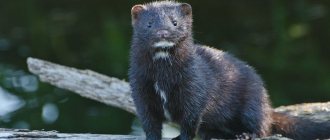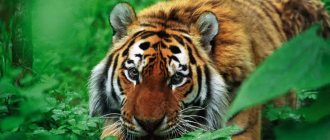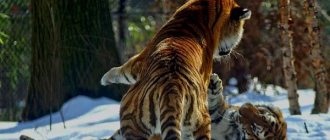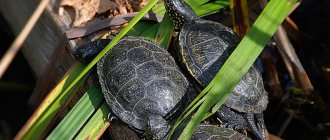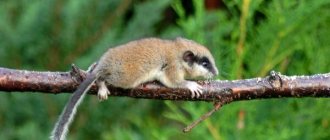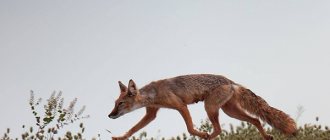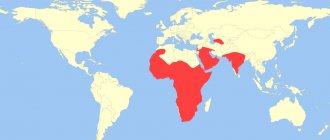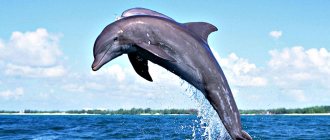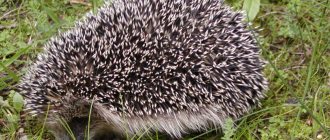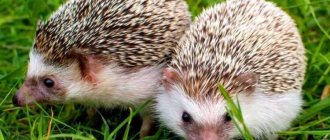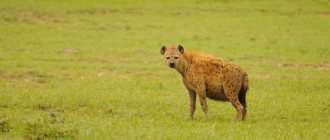Mink is a representative of the mustelid family with valuable fur. There are 2 species of these fur-bearing animals in the wild – European and American. They differ in body size, fur color, as well as anatomical features of the structure of the skull and teeth.
Minks have perfectly adapted to life near water bodies. They swim well and dive well, they can walk along the bottom of lakes and rivers, clinging to uneven ground with their paws. They benefit humans and nature by destroying numerous forestry/agricultural pests - mouse-like rodents. They are close relatives of ferrets, stoats, and weasels.
The American mink (Mustela vison/Neovison vison) is native to North America, the European mink (Mustela lutreola) is native to Eurasia. Currently, both species of these predators live in Europe. The American mink was brought to the largest continent in 1928 for the purpose of breeding on fur farms and nature reserves. A little later, animals with valuable fur began to be released into the wild. The American species quickly adapted to the conditions of the wild on the European continent and over time began to displace the European species from its ancestral territories.
Scientific classification
- Kingdom: Animalia (animals)
- Phylum: Chordata
- Class: Mammalia (mammals)
- Order: Carnivora (predatory)
- Family: Mustelidae (mustelidae)
- Genus: Mustela (weasels and ferrets)
- Species: Mustela lutreola (European mink)
Photo: lutreola.eu
There are seven recognized subspecies of European mink:
- French mink (Mustela lutreola biedermanni) – France;
- Eurasian mink (Mustela lutreola binominata) – Eurasia;
- Central European mink (Mustela lutreola cylipena) – Europe;
- northern mink (Mustela lutreola lutreola) – Europe and Siberia;
- Central Russian European mink (Mustela lutreola novikovi) – Russia;
- Romanian mink (Mustela lutreola transsylvanica) – Romania;
- Caucasian European mink (Mustela lutreola turovi) – Caucasus.
Spread range
Geographical distribution
Photo: Alexander Kurthy
The historical distribution of the European mink was from the Basque region of northern Spain in the west to the Ob River basin in the east and from the vicinity of Arkhangelsk in the north to the Caucasus in the south. An extensive expansion of its range (900 km) across the Urals was observed from 1871 to 1932. Mink first migrated to France in the early 19th century, reaching Bordeaux by 1942 and Dax by 1950. A continuation of this expansion of the range became Spanish territory. The current distribution of the species has decreased significantly.
Natural habitat
European mink are primarily found along small forest streams , which do not freeze completely in winter. Sometimes they are found in the area of large rivers; They give preference to areas of small tributaries. These animals are rarely found on the shores of lakes.
Photo: ALHarrington
Nests and shelters, well protected from bad weather and predators, are established under the roots of trees and stumps, in scattered stones, under collapsed buildings, along the banks of watercourses, in windbreaks, and in the hollows of fallen trees. Each animal has from one to three burrows , which it regularly visits to rest during the day. The hemispherical chamber is lined with dry grass, leaves, feathers or rodent fur. The internal diameter is 20-35 mm, and the wall thickness is 7-10 mm.
- Biogeographic regions: Palearctic
- Terrestrial biomes: forest
- Aquatic biomes: rivers and streams
Appearance
With its small size and beautiful appearance, this animal does not give the impression of a predator, although in fact it belongs to the species of predatory mammals.
This is what a mink looks like:
- the size of the body is small, no more than half a meter in length;
- elongated body shape;
- tail from 15 to 18 centimeters;
- the muzzle is narrowed downwards;
- ears are small;
- bead-shaped eyes, endowed with expressiveness and liveliness;
- legs are short, covered in thick fur, with membranes between the toes;
- weight from one and a half to three kilograms;
- short, smooth, dense fur;
- The color is almost uniform.
Character traits
Appearance
The European mink is often confused with the ferret and the American mink. The European mink has brown guard hairs and undercoat, while the tree ferret has blackish guard hairs and a light gray to light brown undercoat. The European mink's upper and lower lips are white, while its American cousin usually has only the lower lip white.
Photo: Joel Sartore
They are medium-sized predators with a long body, short limbs and a relatively short tail. Feet with interdigital membranes , like other representatives of the genus. The hair on the body and tail is relatively the same length. The soles of the paws are covered with sparse hair. The color of the European mink is dark reddish-brown with a white border around the mouth. Sometimes there are white markings on the throat, paws and chest. Winter fur is longer and denser than summer wool. , a thick, water-repellent undercoat also grows .
Anatomical features
Minks occupy an intermediate position in body shape between otters and terrestrial mustelids. However, various authorities note that the European mink is not as efficient in water as the American mink.
Autumn molting begins in the second half of August and ends in November. The spring molt begins at the end of March and ends in May.
As juveniles develop from 5 to 25 days, their rectal temperature rises from 32.5 to 35.3 °C with a pulse of 210-300 beats per minute. In adults, the body temperature is from 36.2 to 38.4 °C with a similar pulse of 210-300 beats per minute. But the respiratory rate at the age of 1 month to 1 year decreases from 90-120 to 40-65 breaths/min.
- Average body length: 37.8 cm (males), 31.5 cm (females)
- Tail length: 12 to 19 cm
- Body weight: from 0.55 to 0.8 kg
Natural enemies
European minks have two main natural enemies: the otter and their relative, the American mink, which was brought into Russia and almost everywhere began to oppress and even destroy smaller “Europeans.”
In addition, diseases, mainly parasitic ones, which are carried and spread by American minks, also pose a danger to the European mink. Natural enemies of mink also include ferrets, golden eagles, large owls and foxes.
Return to content
Lifestyle
European minks have keen eyesight . The main periods of activity are at dusk (16:00-22:00 hours) and before dawn (05:00-10:00 hours). The European mink leads a more sedentary lifestyle than its American cousin. In extremely cold weather, these mammals do not leave their shelters.
European minks are good swimmers and divers. When swimming, these animals row simultaneously with their front and hind limbs.
Lifestyle and habits
It leads an isolated life, making its home in burrows that it digs itself or borrows from weaker individuals. The animal does not leave its “home” except during the winter cold, when it needs to look for food.
The mink's housing is small and includes a place to sleep and a toilet. She is extremely clean. There must be two outputs.
The European mink lives mainly in water and only occasionally looks into a land shelter.
The animal swims well and can climb a tree if necessary. Lives by hunting. He prefers to settle closer to beavers so that he can use their passages to hunt under the ice in winter. She is very thrifty and fills her hole with food supplies for winter.
Eating habits
Photo: Iryna Mei
European minks consume a wide range of foods, mostly aquatic. Examination of the stomachs and excrement showed that they contained residues of the following food products:
- mammals (moles, water voles, muskrats, shrews);
- fish;
- frogs;
- insects;
- crayfish;
- shellfish;
- birds;
- vegetation.
Some individuals stock up on small amounts of food.
Feeding characteristics of the European mink
The diet of the European mink includes almost all small animals that are found in or near bodies of water. It consists of mouse-like rodents (mainly water rats), fish (perch, minnows, tench, squint, brown trout), amphibians (frogs, their eggs and tadpoles), crayfish, aquatic insects and mollusks. Near villages they can hunt poultry and pick up food waste. They still prefer fresh prey, and in captivity they can starve for 3-4 days in its absence. Before cold weather, minks stock up in shelters (frogs, fish, small rodents, birds).
Reproduction
The mating season begins between February and April . Estrus begins in most animals in the second half of April, the earliest start is March 20, and the latest end is June 30. The most effective mating occurs in the last 10 days of April. Estrus usually lasted 3-6 days. Sexual intercourse lasts from 40 minutes to 3 hours.
Photo: tallinnzoo.ee
The gestation period ranges from 40 to 43 days. From two to seven cubs are born . At birth, males average a total length of 73.9 mm and weigh 8.4 grams, while females average 71.9 mm and 7.6 grams. The external auditory opening opens after 23-27 days, and the eyes open at 4-5 weeks of age.
Teeth appear earlier (15-17 days) than in the American mink (18-21 days), with complete replacement at approximately the same age (60-67 and 62-72 days, respectively). Tracking, capturing and eating prey begins at 52-62 days of age. The young begin to disperse at the age of 2.5 to 4 months. Females become sexually mature at 9-10 months of age.
- Average gestational age: 6 weeks
- Average number of offspring: 4 cubs
- Weaning: 10 weeks
- Age of sexual or reproductive maturity: 9 to 12 months
- Average life expectancy: 10 years
What does it look like
In general, the mink is a predatory mammal belonging to the mustelidae family. The greatest activity occurs in the dark and at night. The body length is 28-45 cm with a body weight of 500-800 g. The marten fur is short, but at the same time thick and dense, preventing it from freezing even in cold weather. The color is dark brown or it can also be called “dark chocolate”, brown, reddish, but it is not uncommon for the animal to have a stripe or spot on the chin or chest. By the way, the mink’s physique is interesting, and even resembles a ferret! After all, the body is long, the muzzle is narrow, the tail is thick, the ears are small, and the paws are strong.
Of course, for housing, the mink chooses forests overgrown with grass, not far from swamps or rivers. Water helps the rodent not only hide from the enemy, but also get food. After all, the diet includes not only small rodents, but also frogs, fish (perch, brown trout, tench, gudgeon, squint), crayfish, mollusks, aquatic insects and even garbage! True, the animal eats waste extremely rarely, still preferring fresh food.
Interspecies interactions
The main predators of the European mink are humans, the polecat, the American mink, the golden eagle and large owls. This animal was caught for a long time because of its valuable skin. On average, 50,000 individuals were caught annually in the USSR alone.
European minks were caught mainly with the help of dogs and traps. In the fall or early winter, one or two hunters, accompanied by one or more dogs, used nets to catch minks from hiding places along the banks of the stream. In winter, traps and live traps were set for minks.
Save Status
The European mink is listed in the IUCN Red List. This species became extinct in Germany at the end of the 19th century. In Poland, the last specimen was discovered in 1915, in Hungary - in 1952. Romania still has a viable population in the Danube Delta. In Finland, mink numbers began to decline rapidly in the 1930s, with the population almost extinct by 1946. In Russia, the European mink population is steadily declining in distribution and numbers.
European mink is protected by law in all countries.
The reasons for the extinction of the European mink across much of its former range are unclear. Population declines, perhaps initially caused by natural climate change, have been exacerbated by deforestation, drainage of wetlands, and pollution of waterways. There is no evidence that the American mink or polecat caused the extinction of the European mink, since the latter's decline was generally not synchronous with the emergence and disappearance of these predators.
Hunting and fishing
Fishing activities in relation to the American mink species do not need to be limited, since the number of its European counterpart has noticeably decreased. In order to somehow increase the number of valuable animals, it would be useful to carry out appropriate measures to resettle the mink. This will, in turn, help increase hunting opportunities for hunters and fishers.
